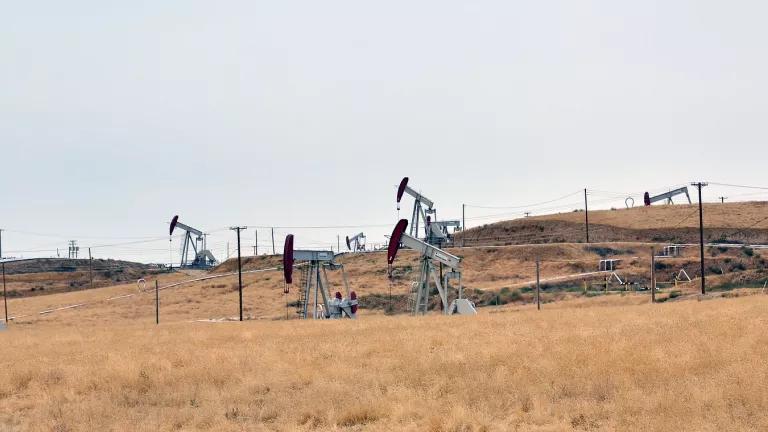Rule to Speed Oil Drilling in National Forests Released

The Trump administration took the wraps off a new rule that will make it easier to drill for oil and gas in national forests. At a time when communities are suffering from dirty air and the dangers of a warming planet—from wildfires and heat waves to hurricanes and derechos—we cannot afford to transform critical carbon sinks into drilling sites that threaten our health and collective future.
For more than 50 years, robust public participation in management of the National Forest System has resulted in the conservation of critical ecosystems and priceless natural resources. Because of the myriad uses of these 193 million acres spanning 47 states, a wide array of stakeholders have a strong interest in preserving the economic, spiritual, recreational, and environmental value of these forests and grasslands. And preserving these values for the future prosperity and well-being of all isn’t just the right thing to do, it’s commanded by the law governing their management.
The potential for conflict between these uses—especially development related to logging and mining versus recreational uses or conservation uses—has yielded robust debate for decades about the most prudent uses of these vast stretches of land. The new rule, however, seeks to shut the public out of that debate in order to serve the interests of the fossil fuel industry, one of the most destructive industries on the planet. Historically, fossil fuel extraction has had a limited presence on national forest land: as of 2019, only 2.7 percent of the entire acreage of the National Forest System had been leased for uses by the oil, gas, coal, and geothermal industries. Today’s proposal threatens to speed up giveaways of National Forest lands while short-circuiting environmental review.
The most concerning changes that the rule makes to longstanding U.S. Forest Service practices relating to oil and gas leasing have to do with eliminating critical environmental reviews, quashing public participation, and removing important Forest Service oversight. In particular, the rule:
- Alters the process the Forest Service uses to consent to the Bureau of Land Management offering oil and gas leases on Forest Service lands. The new rule requires the Forest Service to give the Bureau consent prior to conducting site-specific environmental reviews required under the National Environmental Policy Act (NEPA), even when existing environmental analyses are outdated.
- Eliminates the Forest Service’s current review process for specific lands being offered for lease, in which the Forest Service determines whether NEPA has been adequately addressed and whether leasing is consistent with the Forest Service’s management plans.
- Removes the requirement that the Bureau of Land Management confirm the Forest Service’s consent prior to starting a lease sale, making it more difficult for the Forest Service to stop harmful lease sales.
- Eliminates the requirement of public notice, and the opportunity for public comment, of the decision to approve the plan an oil and gas driller would follow—known as a Surface Use Plan of Operations—when developing a drilling site.
- Eliminates the requirement that the Forest Service review the environmental consequences of drilling operations before approving a surface use plan.
- Gives drilling operators the right to request unlimited extensions to deadlines to fix violations of terms of the Forest Service’s management plans, even when those violations are the result of negligence or misconduct.
When combined with the Trump administration’s NEPA rollbacks, the new rule will speed up oil and gas drilling on Forest Service lands while reducing transparency and curtailing environmental review.
While the rule will affect forests across the country, forests across the Interior West could see some of the biggests changes. By compiling reports from the Bureau of Land Management, the Wilderness Society and Rocky Mountain Wild have mapped the forests in Colorado, Montana, Nevada, New Mexico, and Utah where there is known oil and gas potential. As of this writing, these forests and grasslands include:
- Arapahoe, Medicine Bow, Routt, Gunnison, Grand Mesa, Uncompahgre, White River, Pike, San Juan, Rio Grande, Comanche, and Pawnee in Colorado;
- Beaverhead, Deerlodge, Custer, Gallatin, and Helena in Montana;
- Humboldt-Toiyabe in Nevada;
- Santa Fe, Carson, Cibola, Gila, Lincoln, and Kiowa in New Mexico;
- Ashley, Wasatch, Uinta, Cache, Manti-La Sal, Fishlake, and Dixie—representing every national forest in Utah
Many of these forests are near Tribal lands and include the traditional territory of Indigenous Peoples, raising added concerns that this rule will further undermine Indigenous interests and sovereignty as it undercuts public input on land management decisions.

The West is far from the only region likely to be affected. National forests in Ohio, West Virginia, Virginia, and Kentucky, for example, overlay oil and gas deposits and contain several hundred production sites. For example, the nearby Allegheny National Forest in Pennsylvania, which overlays privately-owned minerals and has been subject to extensive drilling, paints a stark picture of what any push to sell off federal rights to oil and gas resources could do to national forests elsewhere in the country. Further south, national forests in Arkansas, Mississippi, Alabama, and Louisiana have all been identified in past analyses as having potential for oil and gas development.

At the end of the day, this rule represents another example in the long list of irresponsible federal land management choices that have become a hallmark of the Trump administration. In the face of intersecting crises related to biodiversity loss, climate change, and the onset of a global pandemic, the administration has barreled ahead with selling off rights to public lands to the oil and gas industry. In doing so, they are exacerbating growing environmental catastrophes that require land managers to essentially take the exact opposite course. This moment requires ecosystem rehabilitation and recovery, an end to fossil fuel extraction, and the conservation of natural forests. Allowing more fossil fuel drilling with less public review threatens the future of these landscapes that people across this continent have relied on for thousands of years.

